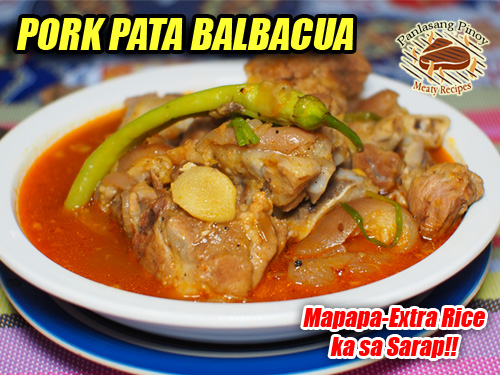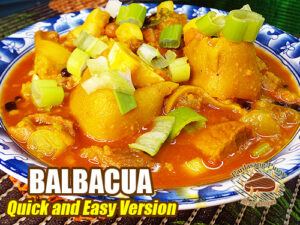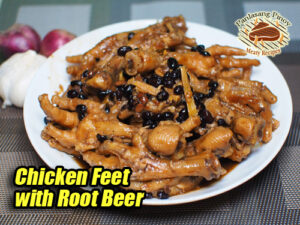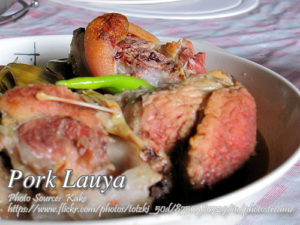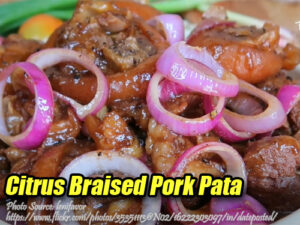Pork pata balbacua is a pork version of the famous “balbacua” made from ox feet or ox skin with some beef. The recipe here is a simplified version but you will be surprised how tasty it is even with few ingredients. The main ingredient used in pork pata balbacua is pork hocks or knuckles and it is easier to find this in the wet market or even in supermarkets compared with ox feet.
Pork Pata Balbacua: A Comforting Take on a Classic Filipino Stew
As a child growing up in Davao, balbacua was one of those dishes that seemed to fill the house with an aroma so comforting, you knew something special was brewing in the kitchen. My uncle Tito Ramon would always talk about how, back in the day, balbacua was made with ox feet or skin, a delicacy that required hours of slow cooking. But when life did get busier and ox feet became increasingly scarce, my mother modified the recipe—to include pork pata, or pork hocks. That version of balbacua became a household staple, easier to prepare but no less sumptuous in flavor.
The pork pata balbacua may not be the traditional version of the balbacua we grew up with, but it brings a similar depth of flavor with fewer ingredients and more accessible cut of meat. This recipe that I’m sharing today is what inspired me by my family’s memories and taste of home.
A Nostalgic Twist With Simple Ingredients
There’s something magical about the simplicity of this dish. Pork hocks are the perfect ox feet substitute – tender, fatty, and best. My cousin Josie used to talk about how much more accessible pork hocks were if she’d even moved to Cebu. She said that the dish reminds her so much of home and that familiar flavors, no matter where, make her feel close to our roots even when she is far away.
The beauty of this pork pata balbacua lies in its simplicity. You start to boil the pork pata until it becomes really tender and juicy. In our house, my Lola Lina would always remind us that whenever we cooked, we had to let the meat simmer slowly enough that the collagen in the skin will break down, making the broth rich and sticky-a hallmark of a great balbacua.
Now, we sauté the garlic and onions together with annatto oil after the meat is boiled. The reddish hue that the oil gives to the dish brings me back to fond memories of family gatherings where my tita would stir the pot carefully, letting the bright colors and enticing smells draw us closer to the table. That warmth, on the other hand, is added by ginger, and a splash of patis—fish sauce—brings in that signature Filipino umami that’s really hard to resist.
Tasty Shortcut with Pork and Beans
What’s really different about this version is the pork and beans. Now, I confess that when my mom opened a can of pork and beans and added it to the pot, I was a little apprehensive. She explained that this was a trick her friend Aling Nena learned from running a carinderia in Mindanao. It is a super shortcut that thickens the stew and lends it yet another layer of sweetness that offsets the richness from the meat.
It’s such a creative way to elevate pork pata balbacua without having to spend hours simmering. My brother Jun, now living in Manila, swears by this recipe. He told me after a long day at work, this dish turns together so quickly yet really tastes like it’s been cooking for hours. Every time he bites into it, he says it reminds him of those family dinners, and he often calls me to reminisce about the same.
A Taste of History in Every Bite
Balbacua trace their origins back to the bottom rungs of Filipino culinary history where traces of it are found in southern regions of Cebu and Davao. This originally was a way of getting tougher cuts of meat-like ox feet or tail-to melt tenderly by slow-cooking them. I always like to believe that the first inspiration for this particular dish came from the Spanish. By name, it speaks of “barbacoa,” or cooking meat over an open flame, but it long since evolved into the stew that exists today.
What made this dish special in my family was not only the flavors but the amount of time it took to prepare. It’s a treat for special occasions, something to share with loved ones. Lola would always say that the best dishes are those which took time, and really, this dish proves her words: even as we have used pork instead of the ox feet, there still lies the semblance of balbacua – a pot-cooked stew that ponders deep, rich flavors giving off the taste of home.
Tips for the Novice; Making Pork Pata Balbacua Yours
That is a scary dish for a kitchen neophyte, but it’s really simple and forgiving, considering how complicated it sounds. Just make sure that you give the pork pata enough time to soften up and don’t rush things. My mother always told me that “patience is the key to a good stew.” And she was right; there was something extremely gratifying in watching all of those ingredients come together and deliver their bit to the depth of flavor.
For those who want it their own, add your twist; you can add your vegetables, say pechay, or carrots just to make it healthy and hearty. My aunt Lita told me that she liked a handful of spinach thrown in just before serving – nice fresh finish for the stew.
Serving and Enjoying the Dish
No meal was ever eaten unless accompanied by a large bowl of steaming white rice. Soft, gelatinous pork is great coated in the rich, tomato-based broth, and I remember my father swooping the stew onto his plate, mixing it with rice, and a satisfied smile while downing every bite. Siling haba only gives a slight heat, which is just enough to cut through the richness without overpowering the palate.
This pork pata balbacua will surely be a comfort dish for a long weekend lunchtime meal with your family or after work. It’s more than just a meal: it will warm the stomach, but stir memories of home and tradition. Every time I make it, it reminds me of the countless generations of cooks in my family who passed their wisdom to me from generation to generation. So this recipe is going to be special for me.
So on to the apron, then enjoy this comforting stew that’s been enjoyed by generations of my family.
Pork Pata Balbacua
Ingredients
- 1 kilo pork pata sliced or chopped
- 1/4 cup tomato sauce
- 3 cloves garlic chopped
- 1 pc onion chopped
- 1 inch ginger sliced
- 1 Tbsp. patis (fish sauce)
- 1 small can pork and beans
- 2 stalks lemon grass tie into a knot
- 1 tsp. salt and pepper
- 2 Tbsp. annatto oil
- 2 pcs siling haba (long green chilis)
- 2 stalks leeks or spring onions
- water for boiling
Instructions
How to Cook Pork Pata Balbacua
- Put the pork pata in a pot and add water just enough to cover the meat. Boil the pork pata until tender.
- Heat annatto oil in empty pan and sauté garlic and onions until fragrant. Add sliced ginger and stir.
- Add patis and simmer for a minute. Add black pepper and tomato sauce. Stir the ingredients for a few seconds.
- Add the boiled pork pata and stir again. Add pork and beans, lemon grass and pork broth from the boiled pork pata.
- Let it simmer again until the broth is reduced and slightly thick in consistency. Add siling haba and spring onions or leeks.
- Let it cook for another minute then turn off heat. Serve hot with cooked rice and enjoy!
Video
Notes
Cooking Tips of Pork Pata Balbacua:
Simmer the Pork Pata for Maximum Tenderness
The slow simmer is another way of doing that fall-off-the-bone tenderness. Annatto oil gives it a rich, gelatinous texture or stew quality as the collagen breaks down during this process. This cannot be rushed, and therefore, it requires a lot of patience because if you rush this aspect of the cooking process, it will definitely toughen out the meat.Add flavor with Annatto Oil
With sautéing the garlic and onions in annatto oil, it is not just giving the meal an ornamentally reddish color but also giving a slight earthy flavor. Annatto oil can be prepared at home by steeping annatto seeds within hot oil until they infuse their deep red or yellow hue. The simple addition can raise not just the presentation of the final dish but also the overall taste.Adjust for Consistency to Your Taste
If you prefer it thicker stewed, let the broth cook a little longer to reduce more of the liquid and thicken up the flavours. If too thick, it's always possible to add a bit more pork broth if need be to make it less thick. This versatility allows you to control the thickness and richness to your own liking.
